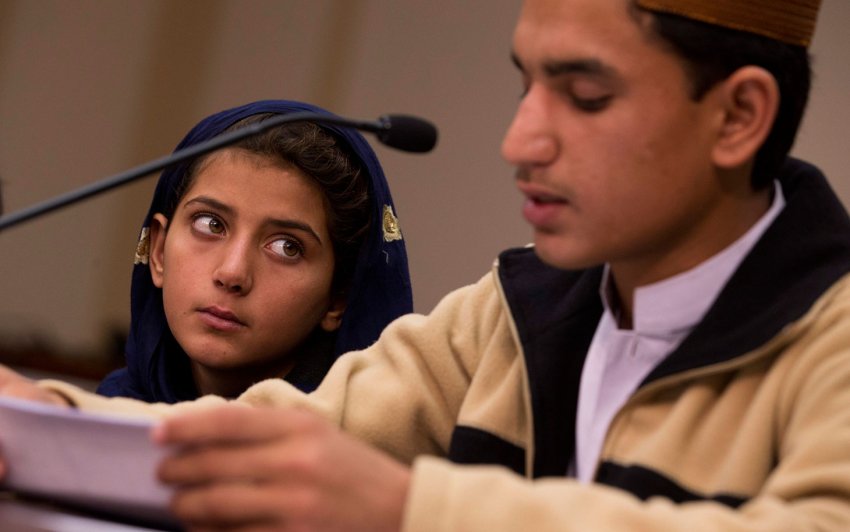
It stands to reason that the perpetrators of crimes against humanity have a vested interest in silencing those who speak out against them.
So it is not surprising there has been an intensified campaign of repression in Pakistan against those speaking out against the US bombing campaign in Pakistan's north-west.
The US drone war in tribal areas of Pakistan, initiated by the George Bush Jr administration and dramatically escalated under Barack Obama, is reported to have claimed about 3500 lives since 2004. This includes nearly 1000 civilians unconnected to militant activities.
A climate of indiscriminate terror has been created. This is indefensible from a human rights perspective and completely counter-productive in terms of eliminating “terrorism”.
In Waziristan, located in the porous border region between Pakistan and Afghanistan, the children shriek at the menacing sound of drones passing overhead. They have seen first hand how death can strike from the skies. The sudden, arbitrary violence often wipes out entire families.
In the US, desk-bound operatives press the kill button and watch the unfolding carnage on computer monitors. So shocking are the scenes that many drone pilots end up with symptoms of post-traumatic stress disorder.
For those on the ground, sifting numbly through pieces of rubble that once were houses, searching for body parts of their loved ones, the effect is devastating.
There is no hiding place in Waziristan from the all-seeing eye of the merciless drone. People live knowing that laser-guided missiles could descend without warning at any time. An entire generation is in effect living under a suspended sentence of death.
For years, this ongoing atrocity has been largely ignored by the corporate media. This caused a lack of public consciousness in the US about the extent of the carnage caused by the drone campaign being waged in the name of national security.
Recently, however, thanks to the tireless efforts of survivors, lawyers and independent journalists, public awareness has slowly begun to grow.
In October last year, three members of a drone-affected Waziri family testified before the US Congress for the first time.
On October 24, 2012, 67-year-old Momina Bibi was out gathering okra in a field in North Waziristan with her two grandchildren when she was instantaneously dismembered before their eyes.
The grandchildren were also injured in the blast, but survived to testify.
Momina’s son, primary school teacher Rafiq ur Rehman, has never received a satisfactory explanation for why the family was targeted. When pressed, Pakistani authorities claimed it was a case of mistaken identity.
The harrowing story of the Rehman family has been documented by Amnesty International and featured in Robert Greenwald's documentary Unmanned: America’s Drone Wars that was released last year.
The Rehman family’s lawyer, Shahzad Akbar, was barred from the US by immigration authorities. Only five Democrat members of the House of Representatives bothered to attend the hearing.
However, it is clear the US and Pakistani agencies responsible for the drone campaign are deeply concerned about the potential for victim testimony to influence public opinion.
After the Rehmans’ groundbreaking visit to Washington, repression has grown in Pakistan against opponents of the US bombing campaign.
This was shown by the recent abduction of prominent anti-drone activist Karim Khan, who lost his teenage son and brother to a drone strike in 2009.
Khan has emerged as a leading voice in the struggle for justice, as detailed by Madiha Tahir's powerful 2013 documentary Wounds of Waziristan.
Khan sought redress through legal channels. “What is the definition of terrorism?” he asked. “I think there is no bigger terrorist than Obama or Bush, those who have weaponry like drones, who drop bombs on us while we are in our homes.”
Khan was abducted on the eve of a trip to testify before the European Union on the effect of drone strikes on civilians. A group of up to 20 men, some dressed in police uniforms, dragged Khan out of his Rawalpindi home.
Driven to an undisclosed location, Khan was kept chained in an underground cellar where he was repeatedly beaten and interrogated about the anti-drone campaign. He was then thrown blindfolded out of a van in the early hours of February 14.
No one seriously doubts this was the work of Pakistan’s Inter-Services Intelligence Directorate (ISI), a CIA-funded agency that has been involved in the disappearance of thousands of Pakistanis.
Although the relationship between the ISI and the CIA is complex and at times troubled, it is clear the two agencies share a desire to stifle the voices of drone victims in Pakistan.
It remains unclear to what extent the CIA was involved in Khan's disappearance. But given previous disclosures, it is reasonable to assume that US intelligence officials were consulted.
In spite of the kidnapping, Khan still plans to testify in Europe.
Khan’s story has received international attention. This makes the ISI's frequently used tactic of assassination to silence unwanted voices harder to carry out.
But many other less well-known Pakistani dissidents are living with the daily threat of ISI paramilitary assassination. This is a development best viewed in the context of the broader global campaign by the US government and its allies against whistleblowers and investigative journalists generally.